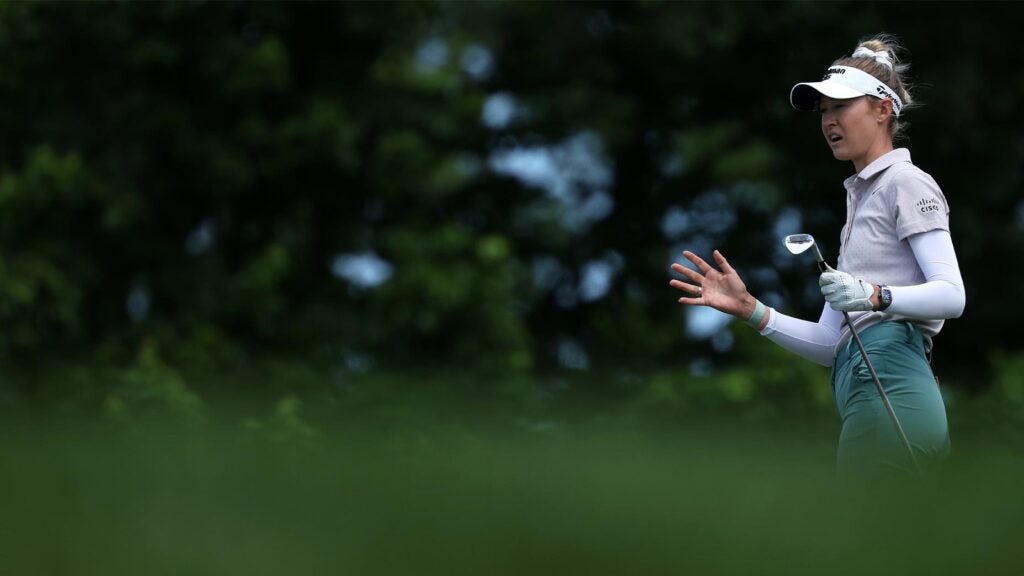LANCASTER, Pa. — The groan arrived at the tee box, confirming the bad news. It was Thursday on the 12th hole at the U.S. Women’s Open and it’d just happened again: somebody had landed a tee shot in the water.
The man standing to the right of the tee box might not have heard the groan. Or maybe he did, but by the time 4 p.m. local time rolled around the groans had grown so frequent and so regular that their existence failed to register with him. In either case, he broke decorum from typical guy-at-a-golf-tournament behavior and whipped out his phone to take a call. A buddy was on the other line, and our friend had something to tell him.
“Dude,” he said, grinning. “I’m here at the U.S. Open, and it’s insane.”
And then a pause.
“The U.S. Women’s Open.”
On Thursday at Lancaster C.C., players battled a golf course whose setup would have tested any professional field. Like all the great U.S. Opens of old, the wind was whipping, the ground was calcified, and the scores went skyrocketing. After Thursday, the number of bogeys-or-worse had more than tripled the number of birdies. And after Thursday, the number of under-par players on supposedly the easiest of the four tournament days sat at just three.
We knew this week would be hard. In Gee Chun won the 2015 U.S. Women’s Open at Lancaster C.C. with a score of 8 under, and for most of the week the leaderboard’s top 10 players were the only ones with a score under par. As the week started, player after player stepped to the podium to share the same perspective: the golf course was hard, it was easy to make mistakes, it was a classic U.S. Open test.
But we didn’t know it would be this hard. Rose Zhang hitting the green with an approach shot and spinning it 15 yards back into the water-hard. Lexi Thompson needing three chips to land her ball on the 10th green-hard. Nelly Korda putting three in the water and making a 10 — a ten!!! — hard. By the end of the day, the scoring average at Lancaster had crept north of five over par, and the players were equal parts dejected and demoralized.
“I knew it as soon as I walked out of the hotel,” said Andrea Lee, the low player from the morning wave. “It was gusting pretty good, even in the morning when I thought it was going to be a little bit calmer compared to the afternoon.”
Lee arrived at the course to find the wind not gusting but outright galing at times, spewing pollen into the air and all manner of golf shots into unfortunate places.
“I just knew it was going to be a grind out there,” Lee said. “I mean, this golf course is such a test. It’s a beast of a golf course, really, and par’s a really good score out here.”
The worst offender of the wind was the 12th hole, a devilish frontward-sloping par-3 with a false front careening dangerously toward a creek. The hole was playing just 161 yards today on the ground, but it played anywhere from 10-20 yards longer into the brunt of the wind. The result was a nearly impossible decision for most of the best players in the field: hit your longer club through the wind and risk hitting it into the back bunker, where a short-sided chip risked (as Korda did after opting for 6-iron and hitting it too far) rolling back into the creek; or hit a shorter club into the wind with the hopes it wouldn’t get gusted straight into the water.
A backup of “25 or 30 minutes” (Korda’s estimation) existed on the hole all day because of this decision, which plagued players on both sides of the ledger. But those watching from outside the ropes didn’t seem to mind the delay — they watched all afternoon long with a perverse joy on their faces, each successive gaffe serving as further proof that this year’s national championship would not provide some cupcake winner.
It helped some that Korda, the week’s head-and-shoulders favorite, plunked three in the water on No. 12 just moments after the tournament started. Her 10 to start the day set the tone for what was going to follow.
“I just didn’t really want to shoot 80, and I just kept making bogeys,” Korda said, minutes after shooting 80 to start the tournament. “Today was just a bad day.”
In a field of 156 players, Korda ended Thursday in a tie for 140th, which will surely lead someone to argue that the U.S. Women’s Open is not fair. And of course, if you’re a TV partner or tournament organizer, it isn’t fair. Korda is a generational talent and one of the true needle-movers in pro golf, and viewers won’t be tuning in by the droves to see if she — and other far-over-par stars like Rose Zhang (+8) and Lexi Thompson (+7) — can fight their way back to the cutline.
But in some ways, Korda, Zhang and Thompson’s scores underlined the point. If the winner of six of the last seven women’s events can deliver a moment capable of relating to even the highest handicapper, then Lancaster isn’t discriminating in its difficulty. And if Lancaster is an equal-opportunity offender, then the U.S. Women’s Open is delivering exactly what we hoped it would.
On Thursday at the U.S. Women’s Open, satisfaction didn’t come in the form of a can’t-miss leaderboard or a hair-raising roar. It came in the form of a groan.
A delightful, devilish, glorious groan.
